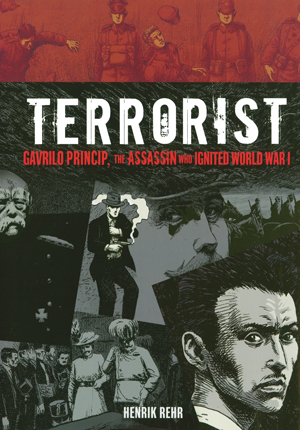Full Text Reviews: Booklist - 03/01/2015 This imagined biography of the Serbian teen whose assassination of Archduke Ferdinand ignited the start of WWI brings a wealth of detail to bolster contemporary understanding of the Great War. In Rehr’s stark and moody black-and-white artwork, the tubercular Gavrilo Princip becomes a fully rounded and even sympathetic character. The circumstances leading up to the start of WWI were complicated, to say the least, but Rehr makes an admirable effort to sift through them by focusing on Princip’s experience of the tumultuous and divisive political atmosphere. After Princip’s world-changing shot, during which the panels slide and skew, distorting the perspective into a chaotic jumble, Rehr shifts focus to the war and its aftermath, particularly the complicated state of affairs concerning the Baltic states, and ends with Princip’s death in prison, as well as the fates of other Black Hand members. With an author’s note providing more detail and a few resources, this would make a good choice for both casual reading for history buffs as well as curriculum support. - Copyright 2015 Booklist. School Library Journal - 02/01/2015 Gr 8 Up—In the words of Prussian statesman Otto von Bismarck, turn of the century Eastern Europe was a powder keg simply waiting for the right spark to explode into what we now know as World War I. The nationalist, revolutionary, and terrorist, Gavrilo Princip, was just the man to set the fire that would ignite the keg. The assassination of Austrian Archduke Franz Ferdinand was the inciting factor that instigated what was one of the 20th century's bloodiest wars. But little is known about the motives behind the assassination. Here, Rehr imagines the circumstances leading up to the killing. Princip and his coconspirators were real people living in a desperate time. They yearned for a free Serbia, Bosnia, and Yugoslavia and were willing to do anything in order to achieve their dream. This intriguing and ultimately harrowing narrative humanizes a historic event. The author is able to breathe life into this confusing and conflict-filled portion of European history. The stark black-and-white artwork and theatrical art-filled splash pages transport readers to 19th-century Eastern Europe. VERDICT This fictionalized account based on historical fact is an excellent contribution to graphic novel collections.—Morgan Brickey, Marion County Public Library System, FL - Copyright 2015 Publishers Weekly, Library Journal and/or School Library Journal used with permission. Bulletin for the Center... - 06/01/2015 The confluence of World War I centennial commemorations and a flourishing market for graphic novels has already produced the brilliantly illustrated Trench Poets collection Above the Dreamless Dead (BCCB 11/14). Now this fictional exploration reconstructs the life of Serbian nationalist Gavrilo Princip, organizer of a cabal to assassinate Archduke Franz Ferdinand (heir apparent to the Hapsburg throne) and the man who fired the fatal bullet. Rehr portrays Princip as a serious, impressionable boy, raised on stories of victories and defeats of his ancestors, and radicalized among anarchists in Belgrade during a chaotic period in which Serbs were politically and militarily squeezed between Austro-Hungarians to the north and Turks to the South. Rehr also pays heed to the philosophical underpinnings of Princip’s adherence to anarchism, a bonus for teen readers who appreciate some intellectual heft in their GNs. Even young adults who skim past the kitchen table and coffeehouse political discussions, however, will be drawn in as Princip methodically strips his life of ephemeral relationships (including his attachment to a young woman he once loved) and dedicates himself to becoming an avenging hero for the Serbian people. Black and white artwork, grainy and hatched to resemble etching, moves skillfully between Princip’s life and that of Franz Ferdinand and his wife, who, despite warnings of an assassination plot, drive willingly and directly to their death. Particularly affecting is Rehr’s segue into the war itself; a series of potent images highlight not only the violence of the battlefields, but the suffering that lingered in its aftermath. End matter includes a map of Europe just before World War I, and an afterword discussing Rehr’s interest in Princip. Source notes are not included. EB - Copyright 2015 The Board of Trustees of the University of Illinois. Loading...
|



